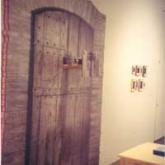Through the Pedagogical Looking Glass
Scott Rigby & David Dempewolf
Through the Pedagogical Looking Glass was commissioned as part of the sight/site exhibition held at the ICA in the spring of 2001. This exhibition addressed the ways in which a work of art’s meaning and reception is altered when placed within new and different contexts.
The commissioned project was a life-size facsimile of Marcel Duchamp’s door from Etant Donnes. It consisted of two inkjet prints mounted on a rigid cut-out of the door. Replacing the eyeholes of Etant Donnes was a projecting library filing drawer, covered with a corresponding inkjet image of Duchamp’s original piece. Within the drawer was a stereoscopic three-dimensional view of the interior tableau of Etant Donnes, which the viewer could see through two holes in the face of the drawer. Filed at the back of the drawer were eight transparent plexiglass cards. Each card bore the name of a writer and a corresponding image summarizing their conception of Etant Donnes in a critical text. Visitors were encouraged to choose a card and place it in a slot in front of the tableau image. When looking through the eyeholes, the image on the card was stereoscopically superimposed on Duchamp’s work. Two feet from the door was a chair and a table; on the table was a spiral bound book of photocopied essays in the form of an academic bulk pack. Reprinted inside the pack was each of the critical texts represented on the plexiglass cards. Visitors were permitted to sit at the desk and leaf through the texts at their leisure.
The work was intended to visually illustrate how critical texts provide audiences with critical and informative lenses to aid interpretation of the artist’s work. These critical approaches to the work carry the ideas, ideologies and biases that were in circulation at the time that the texts were written. By providing a multitude of critical voices, the work was intended to create a clamor of conflicting voices that could cancel one another out, leaving the viewer alone with Duchamp’s Etant Donnes to experience it anew. The viewer is then able to examine a disturbing image on its own terms, without a layer of preconstructed critical interpretation.



